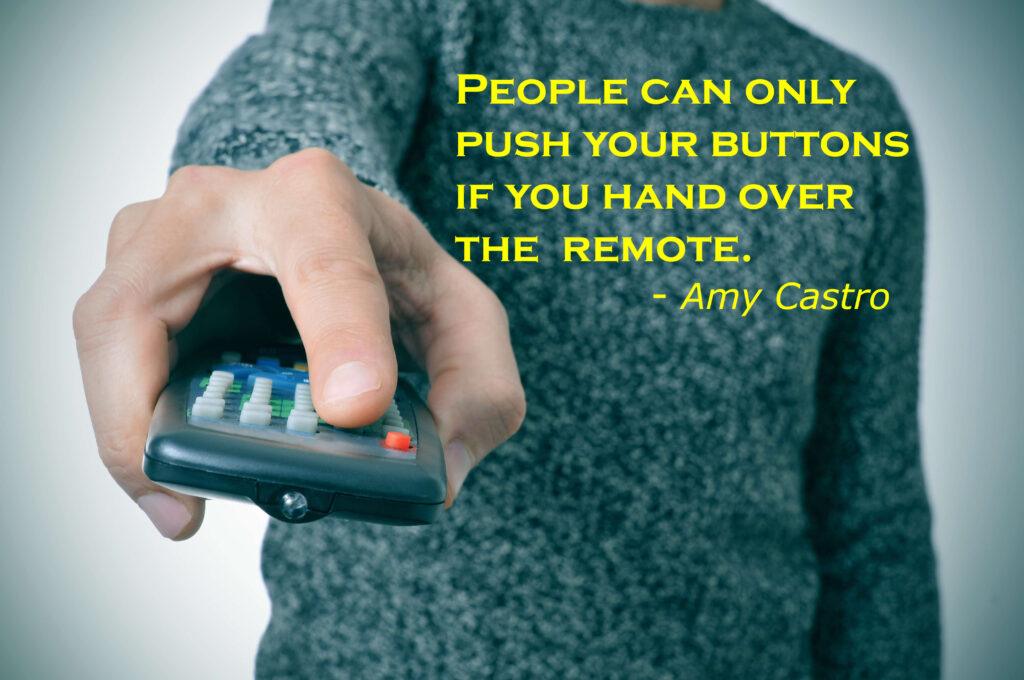When customers are unhappy, they’re generally not on their best behavior. Unfortunately, no matter how much customers “push your buttons” as a professional customer service provider, you have to remain on yours.
It’s not easy, but you can keep your cool when customers heat up by using these five techniques:
1. Take responsibility for your feelings
Many people tend to externalize their feelings. They say things like, “You make me mad,” or “He hurt my feelings.” In reality, our emotions are not a result of anything other people do. They’re a result of what we THINK about what they do.
People can only “push your buttons” if you hand over the remote. Don’t do it.
If a customer yells at me and I think, “Who does she think she is talking to me like that?” I’m likely to get angry. If I think, “I can understand why she’d be upset because she’s not getting what she hoped for,” I’m likely to be more sympathetic. Whether we like it or not, we create our own emotions by how we interpret others’ actions. Therefore, we have the power to control or change those emotions by changing our thinking.
2. Focus on the future, not the past or present
There’s only one phase of time that you can control . . . the future. The past is over and the present is here. When a customer is upset, focusing on the past with comments like, “You should have called us first,” or “Who did you speak with last Tuesday?” are likely irrelevant. Blaming the customer will only make him more angry. Interrogating her about past actions will have the same result. Focusing on the present only gets you stuck in the present. Saying, “calm down,” or thinking, “I can’t believe she’s talking to me like this,” will also escalate the situation.
Instead, focus on the future. Identify your goal and start working toward it. Ask yourself, “Where do I want to be five minutes from now?” and respond to the customer with statements that help you get there. For example, “I can understand you’re upset and I want to help. Let me ask you a few questions to see what our options are to resolve the situation.”
3. Get and use the customer’s name
I’m not Ma’am, Lady, Sweetie, Sweetheart, Hun, Honey, Babe, Baby, or Miss.
I’m Amy.
Research shows that hearing our own names is one of the sweetest sound to our ears. Our names are our identities. Research has also shown that natural use of a person’s name (not overdoing it) causes him or her to like you more and perceive you as more competent and professional.
Before going too far in a conversation with an angry customer, introduce yourself and then ask her name. If the customer says, “Amy”, refer to her as Amy in conversation. If she says, “Amy Castro,” “Ms. Castro,” or “Mrs. Castro,” it’s best to start with Ms. Castro or Mrs. Castro, rather than presuming to use her first name.
A final benefit of using a customer’s name, especially on the phone, is that it acts as a sort of “caller ID.” When I’m complaining over the phone, I’m anonymous and so are you. Once you start using my name, it sends the subtle message that you know who I am and I’m likely to behave a little better than I would if I remained anonymous.
 4. Have acceptable answers to common complaints.
4. Have acceptable answers to common complaints.
Any customer service provider who has been on the job for more than a few days can start to spot complaint trends. Of course, every organization should take those trends and do what they can to eliminate the cause of those complaints. However, there are some things we must do that our customers don’t like. When those things occur, we’d better be ready to explain why we’re doing them. For example, in most healthcare situations, patients are asked to reconfirm their healthcare insurance information at each visit. From the patient’s perspective, this is ridiculous, especially if they know their insurance hasn’t changed.
For example, which response to, “But I just gave you that information at my last visit!” would you find most palatable if you were the patient?
A. “I’m sorry, it’s our policy to get patient insurance information at each visit,” or
B. “I know it can be frustrating to provide your insurance information each time. We ask for it to ensure we always have the most current information about your policy to ensure you get every benefit available to you.”
For those of you who are disagreeable types like I am, you may still be unhappy, but I bet you’d be a lot less unhappy hearing response B than response A.
5. Give customers what they want. Don’t make them fight you for it.
Many organizations have two categories of service they provide. Category 1 is for most people. Category 2 is reserved for those who scream and complain the loudest. As a result, organizations often withhold their best service for those who complain.
If it’s within your power to give the customer what he wants, give it to him up front. Don’t withhold your best, wait for him to fight you, and then say, “Okay fine, here you go.” If a customer’s request is something you just cannot do, for example, giving them a full refund, then be consistent in denying all customers and immediately offer alternatives you CAN provide them, such as a credit or replacement product.









Enjoyed the blog this week. Great reminder for a customer service company like mine. Thank you.
Thank you Renu- the tips are simple, but not always easy to do!